Art Mediums Mont Saintevictoire Seen From Bellevue by Paul Cezanne 1895
Paul Cézanne, Mont Sainte-Victoire, 1902-04, oil on canvas, 73 x 91.nine cm (Philadelphia Museum of Art)
Speakers: Dr. Steven Zucker and Dr. Beth Harris
Information technology can be difficult to estimate, by middle, only how far abroad a mountain lies. A summit can dominate a landscape and control our attention, filling our eyes and mind. Yet it can come as something of a stupor to detect that such a prominent natural feature can all the same be a long distance from united states.
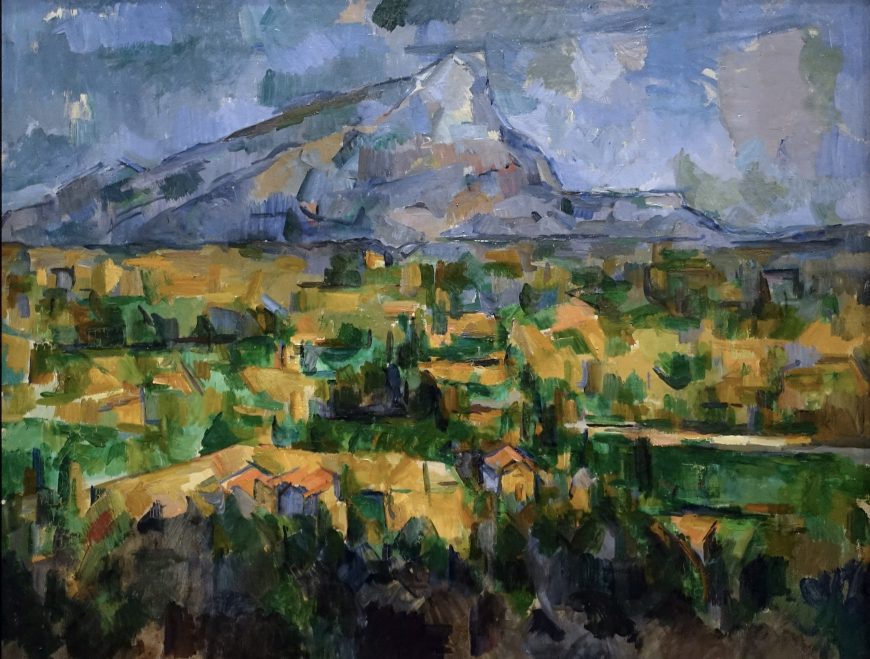
Paul Cézanne, Mont Sainte-Victoire, 1902–04, oil on canvas, 73 x 91.9 cm (Philadelphia Museum of Art, photograph: Steven Zucker, CC BY-NC-SA 2.0)
A mount
At 3317 feet (1011 meters) loftier, the limestone peak of Mont Sainte-Victoire is a pigmy compared to the giants of, say, Mountain Fuji and Mountain Rainier. Only, similar them, it still exercises a commanding presence over the country effectually information technology and, in particular, over Aix-en-Provence, the hometown of Paul Cézanne. Cheers to his many oil paintings and watercolors of the mountain, the painter has get indelibly associated with it. Think of Cézanne and his yet-lifes and landscapes come to listen, his apples and his depictions of Mont Sainte-Victoire.

Paul Cézanne, Bathers at Rest, 1876–77, oil on canvas, 82 x 101 cm (The Barnes Foundation, Philadelphia, photo: BotMultichill, public domain)
Steeped in centuries of history and folklore, both classical and Christian, the mount—or, more accurately, mountain range—simply gradually emerged as a major theme in Cézanne's work. In the 1870s, he included it in a mural called The Railway Cutting, 1870 (Neue Pinakothek, Munich) and a few years later on it appeared behind the monumental figures of his Bathers at Residual, 1876–77 (The Barnes Foundation, Philadelphia), which was included in the Third Impressionist Exhibition of 1877. But it wasn't until the beginning of the next decade, well subsequently his adoption of Impressionism, that he began consistently featuring the mountain in his landscapes. Writing in 1885, Paul Gauguin was probably thinking of Mont Sainte-Victoire when he imagined Cézanne spending "entire days in the mountains reading Virgil and looking at the sky." "Therefore," Gauguin connected, "his horizons are loftier, his dejection very intense, and the ruddy in his work has an astounding vibrancy." Cézanne's fable was beginning to sally and a mountain ran through information technology.
A series
Cézanne would return to the motif of Mont Sainte-Victoire throughout the rest of his career, resulting in an incredibly varied series of works. They show the mountain from many different points of view and often in human relationship to a constantly changing bandage of other elements (foreground trees and bushes, buildings and bridges, fields and quarries). From this series we can extract a subgroup of over 2-dozen paintings and watercolors. Dating from the very last years of the creative person's life, these landscapes feature a heightened lyricism and, more prosaically, a consistent viewpoint. They show the mount every bit it tin be seen from the hill of Les Lauves, located merely to the northward of Aix.
A walk from the studio
Cézanne bought an acre of land on this loma in 1901 and by the end of the post-obit year he had built a studio on it. From here, he would walk farther uphill to a spot that offered a sweeping view of Mont Sainte-Victoire and the state before it. The painter Emile Bernard recalled accompanying Cézanne on this very walk:
Cézanne picked upward a box in the hall [of his studio] and took me to his motif. It was two kilometers away with a view over a valley at the foot of Sainte-Victoire, the craggy mountain which he never ceased to paint[…]. He was filled with admiration for this mount.
Cézanne consciously cultivated his association with the mountain and perhaps even wanted to be documented painting it. When they visited Aix in 1906, the artists Maurice Denis and Ker-Xavier Roussel found themselves being led to the same location. In an oil painting by Denis and in some of Roussel's photographs, nosotros meet Cézanne continuing before his easel and painting the mount. Again! It was the view we can encounter in most of Cézanne's late views of Mont Sainte-Victoire, including the painting that concerns u.s. hither, which is now in the Philadelphia Museum of Art.
The painting in Philadelphia
In this work, Cézanne divides his composition into 3 roughly equal horizontal sections, which extend beyond the three-foot broad canvass. Our viewpoint is elevated. Closest to u.s. lies a band of foliage and houses; side by side, rough patches of xanthous ochre, emerald, and viridian green suggest the patchwork of an expansive plain and extend the foreground'south colour scheme into the middleground; and above, in contrasting blues, violets and greys, nosotros meet the "craggy mountain" surrounded by sky. The blues seen in this section also accent the rest of the work while, conversely, touches of light-green enliven the sky and mountain.
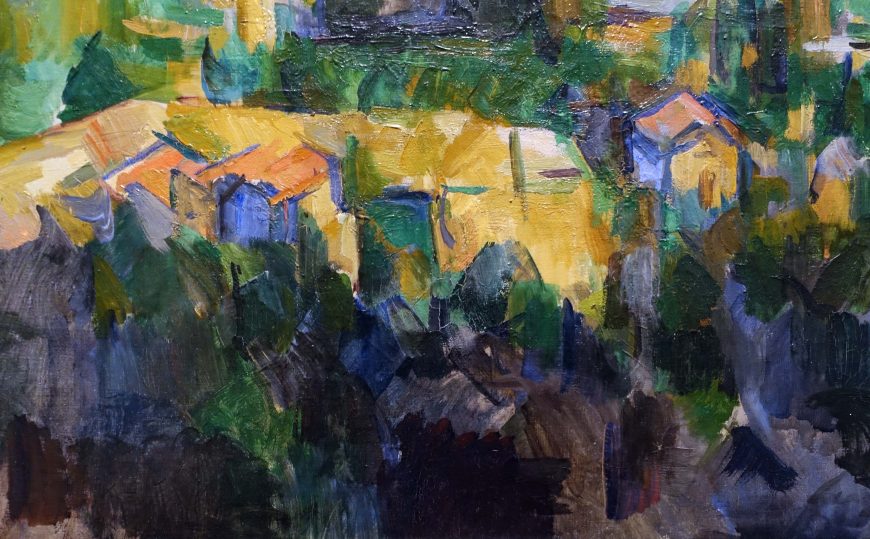
Detail, Paul Cézanne, Mont Sainte-Victoire, 1902–04, oil on canvas, 73 x 91.ix cm (Philadelphia Museum of Art, photo: Steven Zucker, CC BY-NC-SA two.0)
Subtle adjustments
In other words, Cézanne introduced subtle adjustments in order to avoid too unproblematic a scheme. So the peak of the mountain is pushed just to the right of center, and the horizon line inclines gently upward from left to correct. In fact, a complicated counterpoint of diagonals can be found in each of the piece of work's bands, in the roofs of the houses, in the lines of the mountain, and in the arrangement of the patches in the manifestly, which connect foreground to background and lead the center back.
Flatness and depth
Cézanne evokes a deep, panoramic scene and the atmosphere that fills and unifies this space. But it is absolutely characteristic of his fine art that we also remain acutely aware of the painting as a fairly rough, if deftly, worked surface. Flatness coexists with depth and we find ourselves caught between these two poles—now more than enlightened of one, at present the other. The mountainous mural is both within our reach, yet far away.
A comparison
Comparing the Philadelphia canvas with some of Cézanne's other views of Mont Sainte-Victoire and with photos of the area can help usa to grasp some of the perceptual subtleties and challenges of the work. Take the left side of the mount. Though the outermost contour is immediately apparent, inside of it one can also discern a second line (or, more accurately, a series of lines and edges). The two converge only shy of the mountaintop. The surface area between this outer contour and the interior line or ridge demarcates a distinctive spatial plane; this slope recedes abroad from us and connects to the larger mountain range lying behind the sheer face. Attend to this area, and the mount seems to gain volume. Information technology becomes less of an irregular triangle and more of a complicated pyramid.
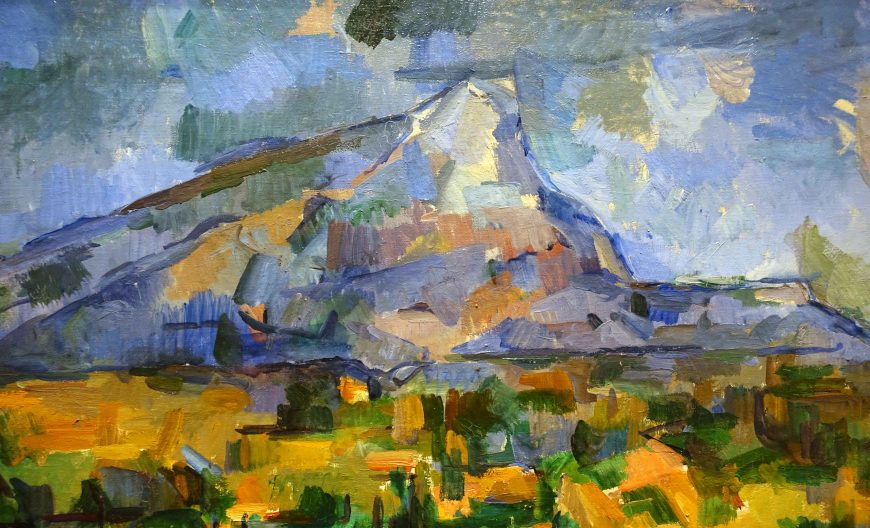
Item, Paul Cézanne, Mont Sainte-Victoire, 1902–04, oil on canvas, 73 x 91.ix cm (Philadelphia Museum of Art, photo: Steven Zucker, CC By-NC-SA 2.0)
Or look again at the painting'southward most obvious focus of involvement, the top of the mount. Cézanne's other works testify that the mountain has a kind of double peak, with a slightly college bespeak to the left side and a lower ane to the right. At first glance, the Philadelphia canvas seems to contradict this: the mount's truncated apex appears to rising slightly from left to correct. Only a closer look reveals that Cézanne does respect topography. The small triangular patch of lite gray—actually the priming of the canvas—can be read equally belonging to the space immediately higher up the mount or perhaps every bit a cloud backside it. Thus information technology is the gray and light blue brushstrokes immediately below this patch that draw the downward slant of the mountain summit.
Curiously, in one respect, our point-of-view is really a footling misleading. At an meridian of 3104 feet (946 meters), the left peak is not the highest point, but simply appears to and then from Les Lauves. A huge iron cross—la croix de Provence—was erected on this spot in the early 1870s, the fourth to be placed there. Though visible from distant, the cantankerous appears in none of Cézanne's depictions of the mountain.
Cézanne had presumably stood on this summit, or these summits, several times. He had thoroughly explored the countryside effectually Aix, showtime during youthful rambles with his friends and later as a plein-air artist in search of motifs. And nosotros know for certain that he had climbed to the top of the mountain as recently as 1895. Armed with these experiences, he could take estimated the distance from Les Lauves to the acme of Mont Sainte-Victoire with some accuracy—it'southward about x miles (xvi kilometers) as the crow flies.
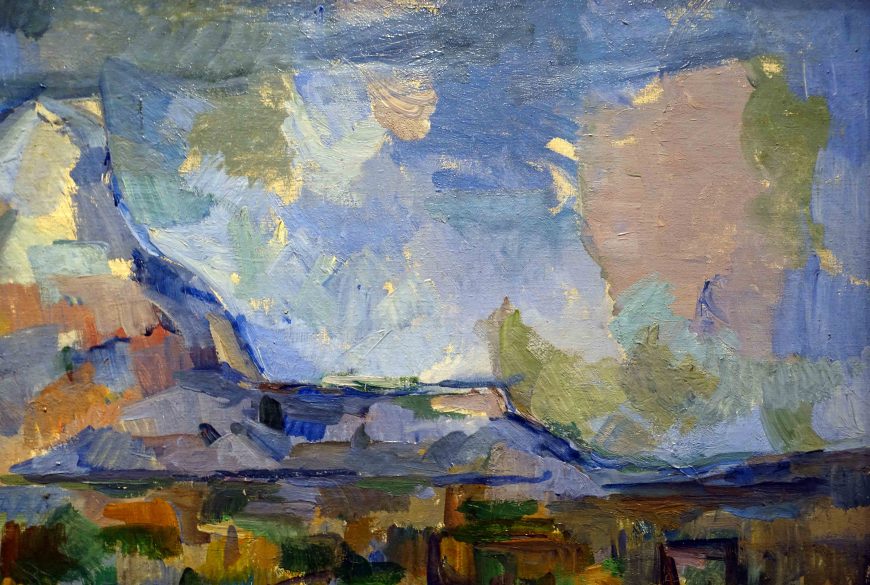
Item, Paul Cézanne, Mont Sainte-Victoire, 1902–04, oil on canvas, 73 x 91.9 cm (Philadelphia Museum of Art, photograph: Steven Zucker, CC By-NC-SA 2.0)
When he stood on the mountain in 1895 Cézanne had, so to speak, entered into one of his own landscapes. As he stood at that place, perhaps he paused to recollect some of the paintings of Mont Sainte-Victoire he had already made. Merely, to return to Gauguin'due south language, could he perhaps take dreamt of the works he would go on to paint in the following decade—works like the Philadelphia landscape, with its high horizon, intense blues, and astounding vibrancy?
Additional resources:
This painting in the Philadelphia Museum of Fine art
Another painting of Mont Saint-Victoire at The Courtauld Gallery
Another painting of Mont Saint-Victoire at The Metropolitan Museum of Art
Cézanne at The Metropolitan Museum of Art'due south Timeline of Fine art History
Smarthistory images for teaching and learning:
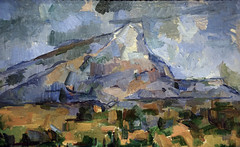
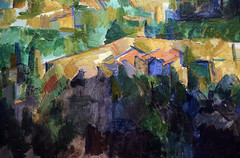
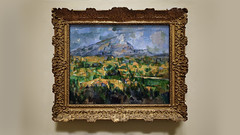
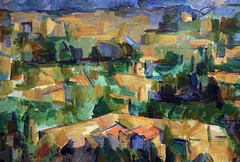
More Smarthistory images…
Source: https://smarthistory.org/cezanne-mont-sainte-victoire/
0 Response to "Art Mediums Mont Saintevictoire Seen From Bellevue by Paul Cezanne 1895"
Post a Comment